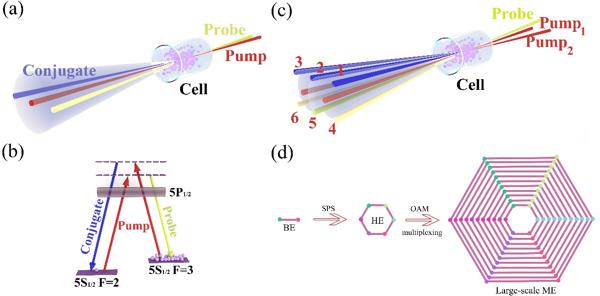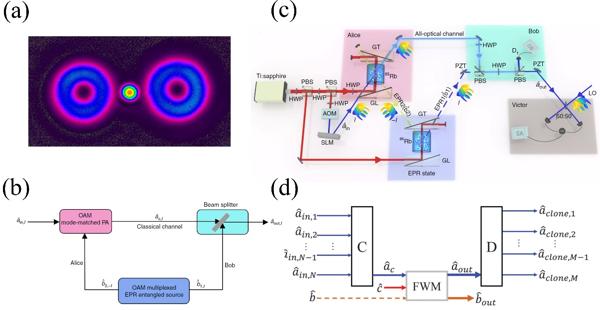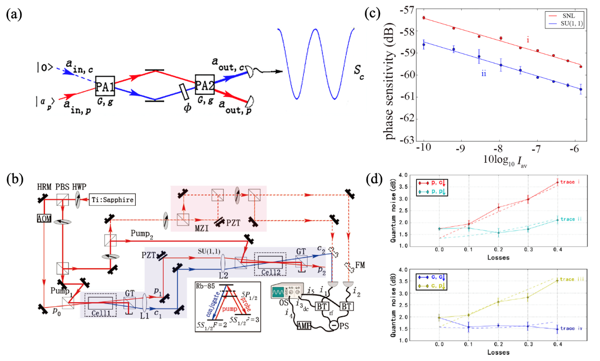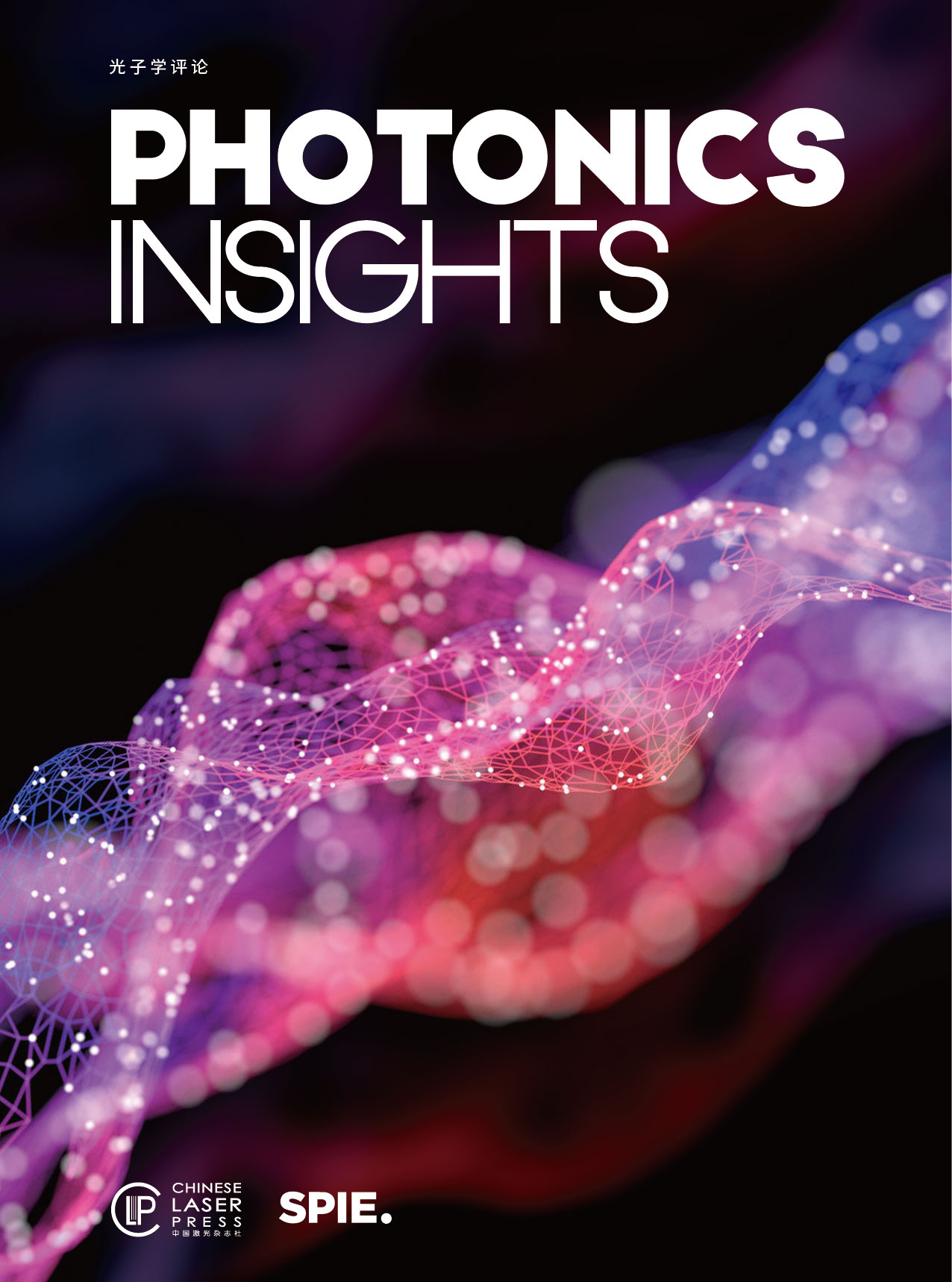Over the past thirty years, with the generation of optical quantum states in the experiments, the field of quantum information science has developed rapidly. A series of quantum information protocols have been proposed and implemented experimentally. For example, quantum teleportation, quantum entanglement swapping, quantum dense coding, quantum key distribution, and quantum secret sharing. The implementation of these quantum information protocols has laid the foundation for the development of quantum communication. At the same time, optical quantum states make the measurement accuracy successfully exceed the standard quantum limit, and they have been widely used in quantum metrology and quantum sensing.
There are many different ways to generate optical quantum states. For example, nonlinear crystals, quantum dots, atomic ensembles and so on. Similar to other systems, optical quantum states from atomic ensembles also have their own advantages. First, the wavelength and bandwidth generated by this system are naturally matched with the atomic transition, and therefore they can be used in building quantum memory. Second, the atomic coherence can enhance the nonlinear interaction strength of the system, resulting in the generation of optical quantum states without using an optical cavity. Therefore, the optical quantum states generated from atomic ensembles have the multi-spatial-mode nature. Due to these advantages, the atomic ensembles have become a promising candidate to generate optical quantum states.
Recently, a team of scientists led by Prof. Jietai Jing at East China Normal University wrote an invited review article, which was published in Photonics Insights, Vol. 1, No. 2, 2022 (Kai Zhang, Shengshuai Liu, Yingxuan Chen, Xutong Wang, and Jietai Jing. Optical quantum states based on hot atomic ensembles and their applications [J]. Photonics Insights, 1(2), R06 (2022)). They introduces the latest progress in the generation of optical quantum states based on atomic ensembles and their applications.
1 Optical quantum states based on atomic ensembles
The four-wave mixing (FWM) process in hot atomic ensembles is an effective way to generate squeezed and entangled states. In 1985, Slusher et al. first used the FWM process in the sodium atom ensemble to generate squeezed states. In 2007, Paul Lett's group at NIST generated the intensity difference squeezing of 3.5 dB in hot rubidium atomic ensemble, and their schematic diagram and the double-Λ energy level diagram are shown in Figs. 1 (a) and 1 (b). Such a process converts two pump photons into one probe photon and one conjugate photon, which leads to quantum correlation between the two output fields. This scheme has been extended to other alkali atoms, such as potassium atoms and cesium atoms. In addition, the phase-sensitive FWM process can further enhance the intensity difference squeezing to a level of 10 dB.
Because the FWM process based on atomic ensemble avoids the use of the optical cavity, it can be used to generate spatially separated multi-beam quantum correlation. By spatially multiplexing multiple FWM processes in an atomic vapor cell, the number of quantum correlated beams generated by cascading multiple atomic vapor cells can be increased exponentially (2n, where n is the number of atomic vapor cells). At present, the four-mode quantum correlation has been generated experimentally by cascading two atomic vapor cells.
At the same time, the spatially multiplexed FWM process can also be realized by utilizing the spatially structured pump fields. Based on the dual-pump structure, 6-mode quantum entanglement (Fig. 1 (c)) and 14-mode quantum correlation have been realized. In order to further increase the scale of quantum networks, a 66-mode quantum entanglement network has been realized through orbital angular momentum (OAM) multiplexing technology (Fig. 1 (d)).

Fig. 1 (a) Schematic diagram of FWM process in hot atomic ensembles. (b) The double-Λ energy level diagram of FWM process. (c) Multi-mode quantum entanglement generated from spatially structured pump field. (d) Large scale multimode quantum entanglement based on OAM multiplexing technology
2 Applications of optical quantum states based on atomic ensembles in quantum communication
The quantum correlated beams generated by the FWM process in hot atomic ensembles are spatially multimode, which can be used to generate spatial multimode quantum states (for example, the OAM entangled state shown in Fig. 2(a)), probe or carry spatial information, for bright illumination and quantum imaging applications. In addition, the atomic ensembles can control the dispersive properties that determine the group velocity of light. Under certain conditions, the FWM process in hot atomic ensembles has slow-light or fast-light effects, which can be used to delay or advance quantum correlation.
At the same time, an all-optical quantum information protocol platform can be constructed based on the atomic ensembles, including all-optical quantum teleportation (Figs. 2 (b)-(c)), all-optical entanglement swapping, low-noise quantum amplifier, all-optical N-to-M quantum cloning (Fig. 2 (d)), and all-optical quantum state transfer machine. The all-optical platform avoids the optic-electro and electro-optical conversion, so it has high information transmission bandwidth.

Fig. 2 (a) The orbital angular momentum entangled state generated by the FWM process. (b) Schematic diagram of all-optical quantum teleportation. (c) Experimental scheme of all-optical quantum teleportation. (d) Schematic diagram of all-optical N-to-M quantum cloning.
3 Applications of optical quantum states based on atomic ensembles in quantum metrology
Quantum metrology is an important field of quantum information. The optical quantum states generated by atomic ensembles can be used to improve the measurement accuracy. The SU (1,1) interferometer (Fig. 3 (a)) based on atomic ensembles is widely used to beat the shot noise limit (SNL). For example, the phase sensitivity can beat the SNL when utilizing the bright-seeded SU(1,1) interferometer (Fig. 3 (c)), and its experimental setup is shown in Fig. 3 (b). The cascaded structure of SU (1,1) interferometer can enhance the quantum entanglement. The effect of losses on the quantum-noise cancellation in the SU(1,1) interferometer is also studied experimentally (Fig. 3 (d)). It is shown that losses in the different arms inside the SU(1,1) interferometer can have different effects on the quantum-noise cancellation in the output fields.
A variation of SU (1,1) interferometer, truncated SU (1,1) interferometer, is also utilized to beat the SNL. For example, it can implement a quantum enhanced atomic force microscopy microcantilever. In addition, the quantum plasmonic sensing using optical quantum states generated by atomic ensembles can also be used to beat the SNL.

Fig. 3 (a) Schematic diagram of SU (1,1) interferometer. (b) Experimental setup to measure the quantum enhanced phase sensitivity of SU (1,1) interferometer. (c) The phase-sensitivity scaling of the bright-seeded SU(1,1) interferometer and the SNL. (d) Experimental and theoretical results for the effects of losses on the quantum-noise cancellation of the SU(1,1) interferometer.
4 Conclusion and future perspective
This review introduces the recent progress on the generation of optical quantum states based on the FWM process in hot atomic ensembles, including the generation of two-mode quantum states, multi-mode quantum states, and OAM multiplexed quantum states. More importantly, we have reviewed the applications of such optical quantum states in the quantum information protocol and quantum metrology. In the aspect of quantum information protocol, we have introduced the all-optical quantum information platform based on atomic ensemble system, which lays the foundation for all-optical broadband quantum network. In quantum metrology, we have introduced the SU(1,1) interferometer and quantum sensing system based on the atomic ensemble system. It is shown that these optical quantum states can be used in various quantum sensing tasks.
The system of optical quantum states from atomic ensemble is still developing and finding new applications. For instance, the optical quantum state generated from hot atomic ensembles will have a larger scale by involving different DOFs, such as time and frequency. With the increase of the scale of the generated optical quantum state, this system can be used to build complex quantum networks and implement distributed, multi-parameter, and multi-channel quantum metrology. The atomic ensemble system will have important applications in the realization of long-distance quantum networks and high-precision quantum sensing in the future.


